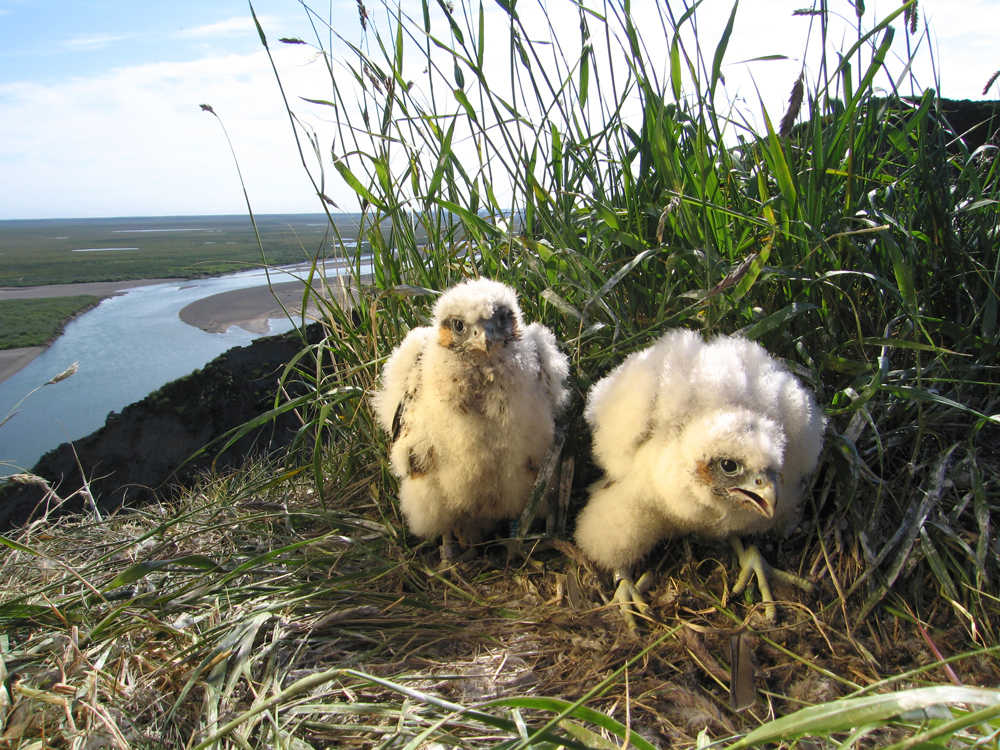The upper Colville River is one of the quietest places on the planet, a land of cliffs and tundra and tangles of willow. Fashion Island is one of the most human-altered landscapes in America, where developers long ago replaced the native vegetation with a Cheesecake Factory and P.F. Chang’s.
Yet a female peregrine falcon born in northern Alaska spent at least one of her winters on the 13th floor balcony of a hotel in Fashion Island, a development in Newport Beach, California.
The contrast between living arrangements still impresses Ted Swem, a biologist with the U.S. Fish and Wildlife Service in Fairbanks. Swem cupped the peregrine chick in his hands above the Colville River in 1988, when he placed a blue band around its leg.
The blue band had two numbers stamped on it to enable biologists to recognize the bird later. Swem hoped to see one of his banded birds return to a nesting site near where it was born. The bands helped him determine which young birds survived to adulthood and where and how long they nested.
The colorful bracelets are mostly a tool for biologists working in the areas where the birds were born. Few others ever report seeing them. That’s why Swem was surprised one day to receive a phone call from California.
While sitting on the sidewalk and aiming a spotting scope at a falcon perched on the Marriott Hotel’s 13th floor, a bird biologist saw the blue tag. He was able to read the numbers on the tag, the color of which indicated it was banded somewhere north of the Arctic Circle.
That biologist, Brian Latta, contacted Swem to see who might know about the bird. Latta knew that Swem monitored the peregrine falcon’s recovery in Alaska after exposure to pesticides made the birds harder to find. Swem checked his records and saw that he had banded the Marriott-perching bird eight years earlier.
In an email to Swem, Latta described his meeting with the Alaska peregrine falcon:
The bird stood on a planter box on the hotel in Fashion Island, “a southern California oasis of material vanity,” Latta remembered. “She was being courted by a resident male (peregrine falcon) and there was a resident second-year female hanging out on a nearby building that eventually replaced her when she went back north. I don’t think (the Alaska bird) allowed the male to copulate but would take his food.”
No one reported seeing the Alaska peregrine falcon again. But the story sticks with Swem as an example of the adaptive abilities of migratory birds.
Born on a cliff 98 miles from the nearest people (a couple and their two dogs in Umiat), that peregrine falcon wintered in a land with 3,587 people per square mile and palm trees imported from somewhere else. Swem figures the falcon was feeding most on non-native birds: pigeons, starlings and maybe parakeets or other pet birds freed from their cages.
“Things couldn’t be less similar to what that habitat was like 200 years ago, and yet it was occupied by peregrines then and now,” Swem said.
As billions of birds are now headed northward for spring migration, the story of the country falcon that wintered in the city is a reminder of why many birds migrate. When summer returns to the far north and stirs insects and other food sources, the kitchen is open. Round-the-clock daylight and ample food gives birds the energy to nest and raise their chicks.
When the tundra stops humming and the northern pantry closes, birds like that peregrine falcon show an ability shared by few humans: comfort in both the least and most populated places on Earth.
• Since the late 1970s, the University of Alaska Fairbanks’ Geophysical Institute has provided this column free in cooperation with the UAF research community. Ned Rozell is a science writer for the Geophysical Institute.

